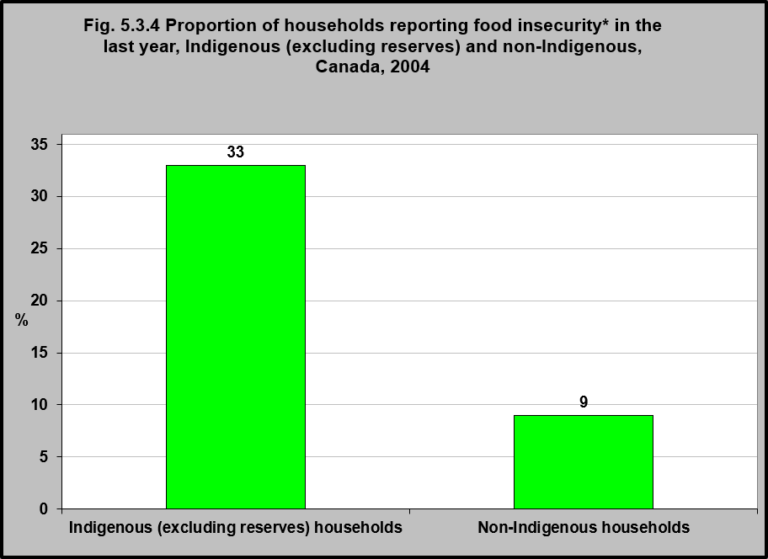Proportion of households reporting food insecurity in the last year, Indigenous (excluding reserves) and non-Indigenous, Canada, 2004

Notes:
*Food insecurity exists within a household when one or more members do not have access to the variety or quantity of food that they need due to lack of money.1
1Statistics Canada Catalogue no. 82-624-X. Food insecurity in Canada. 2015. http://www.statcan.gc.ca/pub/82-624-x/2015001/article/14138-eng.pdf -July 28, 2017.
Source: CICH graphic created using data adapted from Willows ND, Veugelers P, Raine K, Kuhle S. Prevalence and socio demographic risk factors related to household food security in Aboriginal peoples in Canada. Public Health Nutrition. 12(8): 1150-1156 using data from Statistics Canada, Canadian Community Health Survey, Cycle 2.2, Nutrition (2004). https://www.cambridge.org/core/services/aop-cambridge-core/content/view/056403E64C5D4CA0FAFDAA6017EA752A/S1368980008004345a.pdf/div-class-title-prevalence-and-sociodemographic-risk-factors-related-to-household-food-security-in-aboriginal-peoples-in-canada-div.pdf -accessed July 28, 2017.
In 2004, according to data from the Canadian Community Health Survey, 33% of Indigenous households (excluding those on reserves) were food insecure compared to 9% of non-Indigenous households.
Implications
The prevalence of food insecurity is high among Indigenous households (excluding those on reserves), with rates of more than 3 times that of non-Indigenous households.1 Indigenous households'(excluding those on reserve) have a higher prevalence of socio-demographic risk factors for household food insecurity such as poverty. Household food insecurity is associated with poorer health outcomes including, high stress, anxiety and cigarette smoking, which can have impacts on children’s health and well-being.1
1Willows, N., Veugelers, P., Raine, K., & Kuhle, S. (2011). Associations between household food insecurity ad health outcomes in the Aboriginal population (excluding reserves). Health Reports, 22(2), 15-20.
